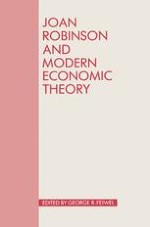1989 | OriginalPaper | Buchkapitel
The Wage-share and the Rate of Exchange of Labor Time
verfasst von : Robert Dixon
Erschienen in: Joan Robinson and Modern Economic Theory
Verlag: Palgrave Macmillan UK
Enthalten in: Professional Book Archive
Aktivieren Sie unsere intelligente Suche, um passende Fachinhalte oder Patente zu finden.
Wählen Sie Textabschnitte aus um mit Künstlicher Intelligenz passenden Patente zu finden. powered by
Markieren Sie Textabschnitte, um KI-gestützt weitere passende Inhalte zu finden. powered by
Joan Robinson subscribed to an elegant model of the real wage in which the wage is related to the average product of labor in the wage-goods sector and the proportion of the total workforce which is engaged in the production of wage-goods. Clearly, this model also suffices to account for the distribution of income (between wages and profits) within the wage-goods sector. Elsewhere (Dixon, 1981), I have set out a model of the wage-share in the economy as a whole, using Robinson’s model of the wage-goods sector as a starting point. In that paper it was shown that the proximate determinants of the economy-wide wage-share are: the proportion of the total workforce which is engaged in producing wage-goods, the price level of wage-goods relative to the general price level, and the level of the average product of labor in the wage-goods sector relative to the average product of labor in the economy taken as a whole. In this contribution I wish to demonstrate that these last two items (i.e. relative prices and relative labor productivities), taken together, are a measure of the rate of exchange of the labor time expended in the production of the various outputs produced in the economy. We are thus able to derive an expression for the economy-wide wage-share in terms of the sectoral composition of employment and the (implicit) rate of exchange of labor time.
